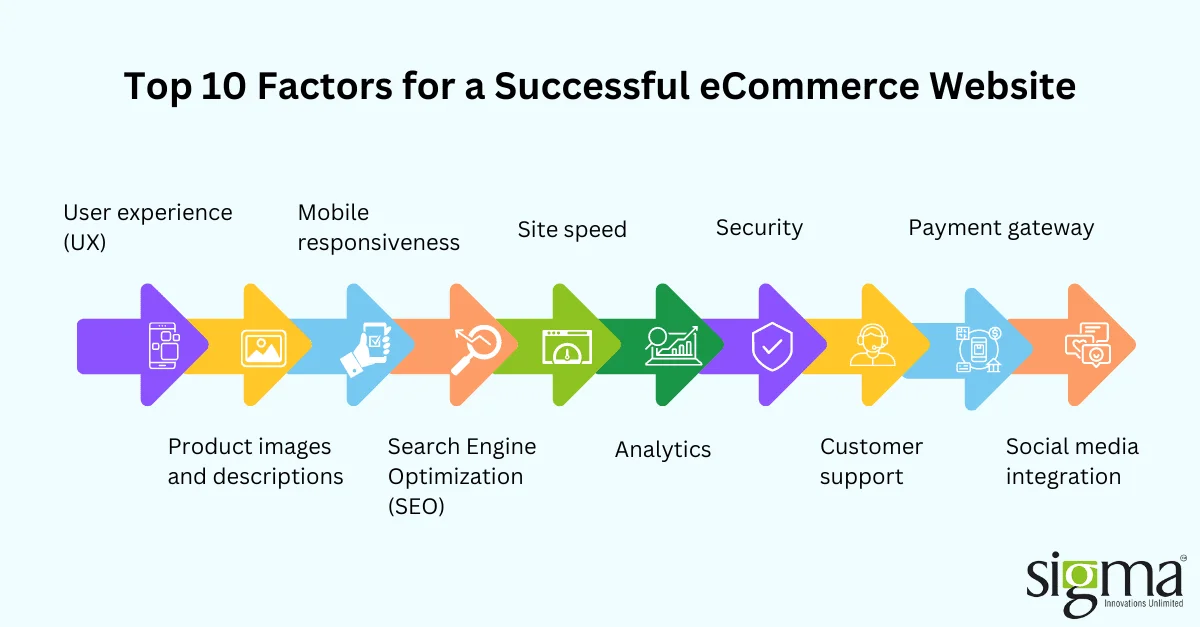Top 10 Factors you need to consider for a Successful eCommerce Website
( Image Credit – Freepik )
eCommerce has become an integral part of modern business operations. With the rise of online shopping, businesses need to develop eCommerce websites to remain competitive. Developing an eCommerce website will be a challenging task that requires careful planning and execution. To create a successful eCommerce store, there are several critical factors that need to be considered. In this blog, we will explore the top 10 things that eCommerce businesses need to keep in mind when developing their eCommerce website. From optimizing the user experience to staying current with design trends, these tips will help you create a captivating & adaptable website that meets the diverse needs of your customers and helps to achieve your desired outcomes.

User experience (UX)
When it comes to eCommerce website design, prioritizing user experience (UX) is crucial for creating a successful online store. Your website should provide a seamless, engaging, and intuitive experience for your customers, from the moment they land on your homepage to the final checkout process. To achieve this, you need to focus on several key elements, such as:
- simple and organized interface
- fast loading items
- mobile responsiveness
- clear calls-to-action
- high-quality product images
- customer reviews
By optimizing the UX, you can enhance:
- customer satisfaction
- reduce bounce rates
- increase conversions
Mobile responsiveness
In today’s mobile-first world, having a mobile-responsive website is no longer a luxury but a necessity. With more people using smartphones and tablets to browse and shop online, your website must be optimized for all devices to provide a seamless experience for your customers. A mobile-responsive website adapts to the screen size and orientation of the device, ensuring that the content is displayed correctly and the navigation is easy to use. This not only improves the user experience but also helps boost engagement, reduce bounce rates, and increase sales.
Additionally, having a mobile-friendly website can improve your search engine rankings, as Google considers mobile responsiveness a crucial factor in its algorithm. By investing in mobile responsiveness, you can future-proof your eCommerce business and stay ahead of the competition. To ensure having mobile-friendly websites, you can utilize Google page speed insights to analyze the report and tools like BrowserStack to check the website on multiple devices.
Some of the recommendations as per Google page speed insights for mobile sites are:
- Proper viewport Configuration
- Size content to the viewport
- Use legible font sizes
- Appropriate Size tap targets
- Stay away from plugins
Complete details can be viewed here
Site speed
Website speed is a critical factor in attracting and retaining customers. Slow-loading websites can lead to high bounce rates and a poor user experience, which can ultimately harm your eCommerce business. To optimize website speed, you need to focus on several key factors, such as image optimization, script minimization, and content delivery networks (CDNs). By optimizing your images, you can reduce their file size without compromising their quality, which can significantly improve load times. Similarly, by minimizing scripts, you can reduce the amount of code that needs to be processed, which can also speed up your website. Finally, by using a CDN, you can distribute your website’s content across multiple servers, which can reduce the distance that data needs to travel, improving load times. A good site speed is typically considered to be a load time of 2-3 seconds or less for the website’s main content to appear on the screen. By prioritizing website speed, you can enhance user experience, increase engagement, and drive sales.
You can go through details on the performance of the website from Google page speed insights
https://developer.chrome.com/docs/lighthouse/performance/.
Some of the key metrics for good page performance are:
- FP/ FCP
- Time to Interactive
- Page speed and load time
- Time to the first byte
- DNS Lookup time
- Peak Response Time
- Hardware utilization
To improve page performance and enhance user experience, it’s important to leverage the latest technologies and frameworks available in the market. Some popular options for front-end development include ReactJS, VueJS, and AngularJS, which are all known for their speed, flexibility, and scalability. These technologies can help optimize website speed, reduce server requests, and improve caching, resulting in faster load times and a smoother user experience.
Additionally, Progressive Web Apps (PWAs) are gaining popularity as a hybrid solution that combines the best features of web and mobile apps. PWAs are fast, reliable, and responsive, and can work offline, making them ideal for eCommerce websites that need to deliver a seamless experience across multiple devices and network conditions. By adopting these latest technologies, you can future-proof your website, stay ahead of the competition, and provide your customers with the best possible experience.
Security
Ensuring online security is of utmost importance for websites. To protect user data, it is essential to have robust security measures in place. One such measure is SSL (Secure Sockets Layer) encryption, which encrypts data exchanged between a user’s browser and your website, preventing unauthorized access. Additionally, implementing two-factor authentication and firewalls can help safeguard against cyber threats, ensuring a safe and secure online shopping experience for your customers.
Payment gateway
Offering secure payment gateways and multiple payment options is crucial for providing a seamless transaction experience for your users. To ensure your customers’ financial safety, it is important that your website is PCI compliant. Popular payment options such as credit cards, PayPal, and digital wallets should be made available to cater to different user preferences. With a variety of payment methods, your customers can conveniently make purchases without worrying about security risks.
Below are different types of payment gateways that can be integrated into your website:
- Hosted payment gateway
- Self-hosted payment gateway
- API-hosted payment gateway
- Local bank integration gateway
Here is some information about the payment methods that can be implemented on a website.
PayPal: PayPal is a widely used online payment system that allows customers to make purchases using their PayPal account or credit/debit card. It provides a secure and easy-to-use checkout process, and many customers are already familiar with it.
Braintree: Braintree is a payment gateway that provides a seamless checkout experience. It supports multiple payment methods, including credit/debit cards, PayPal, Apple Pay, Google Pay, and more. Braintree also offers advanced fraud protection and supports recurring billing.
Authorize.net: Authorize.net is a popular payment gateway that allows customers to make online payments using various methods, including credit/debit cards, e-checks, and digital wallets. It provides robust security features, such as fraud detection and prevention tools.
Google Pay: Google Pay is a digital wallet that allows customers to make payments using their Google account. It offers a fast and secure checkout process and can be integrated with other payment gateways to provide a seamless payment experience.
Apple Pay: Apple Pay is a digital wallet that allows customers to make payments using their Apple devices, such as iPhones, iPads, and Macs. It provides a secure and convenient checkout process, and customers can use Touch ID or Face ID for authentication.
Amazon Pay: Amazon Pay is a payment method that allows customers to make payments using their Amazon account information. It offers a familiar and convenient checkout experience for customers who already have Amazon accounts.
Buy Now Pay Later (Afterpay, Klarna): Buy Now Pay Later options such as Afterpay and Klarna are gaining popularity as they allow customers to make purchases and pay for them in installments over time. These options can help increase conversion rates and provide flexibility for customers who may not have immediate access to funds.
Implementing these payment methods on your website can provide a convenient and secure checkout process for your customers, and potentially increase sales by offering a variety of payment options.
Product images and descriptions
High-quality product images and comprehensive product descriptions are crucial in providing users with the information they need to make a purchase. Ensure that your product images are optimized and load quickly, and provide detailed product descriptions with information such as size, weight, and materials.
Search Engine Optimization (SEO)
Search engine optimization (SEO) is essential for making your services & products visible to potential customers. To increase your website’s visibility, it is essential to optimize it for search engines. This can be achieved by incorporating relevant keywords in your content, utilizing meta tags and descriptions, and ensuring that your website is structured for optimal SEO. By implementing these tactics, your website will rank higher in search engine results pages, making it easier for users to find and engage with your brand. You can get the SEO score of your website on your own from Website Grader and Semrush.
Analytics
Employ analytics tools to monitor user behavior and evaluate the efficacy of your website. This data will enable you to make informed decisions aimed at enhancing the site. Tools like Google Analytics offer critical insights into user behavior, traffic sources, and conversion rates, which can inform strategic improvements.
Customer support
Delivering exceptional customer support is essential to guarantee customer satisfaction and loyalty. Ensure that your website offers various ways to reach out to customer support, such as live chat, email, and phone support. It is crucial to have a well-trained and knowledgeable support team that can provide prompt and effective assistance to customers.
Customer support tools such as Zendesk, HubSpot, Zoho, and LiveAgent are valuable resources for delivering exceptional customer support. These tools offer various features that can streamline customer inquiries, improve response times, and enhance customer satisfaction. Utilizing these tools can help your support team to be more efficient and effective in addressing customer needs.
Social media integration
Incorporate social media platforms into your eCommerce website to elevate brand recognition and customer involvement. Include social sharing buttons on your product pages and leverage social media to disseminate information to customers about new products, promotions, and events. By doing so, you can boost customer engagement and enhance your brand’s visibility in the digital space. In today’s age, linking your website to popular social media platforms such as Facebook, Twitter, LinkedIn, Instagram, and Pinterest is not only common but also necessary.
Conclusion
Developing an eCommerce website requires careful planning and attention to detail. By keeping the above-mentioned ten items in mind, you can create a website that is user-friendly, secure, and optimized for sales and better user engagement. With a well-designed and effective eCommerce website, you can take your business to new heights and increase customer satisfaction and loyalty. Keep in mind that developing an eCommerce website is an ongoing process, and you need to continually update and improve your website to stay ahead of the competition.
At Sigma, with our proven eCommerce expertise across 200+ projects and 500K+ person-hours, we have been a trusted TECH partner for over 18 years in the IT services industry. To learn more about our services and offerings and get the acceleration your eCommerce business needs, please do connect with us.

